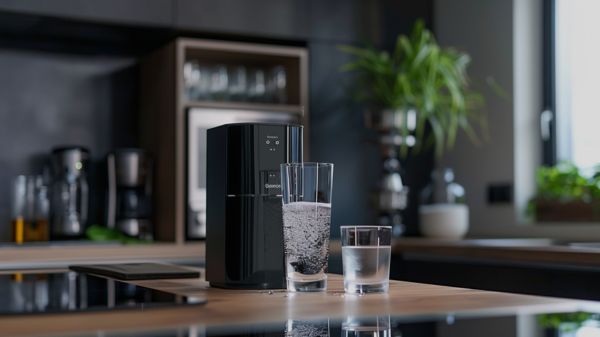You’re looking at a device known as an Atmospheric Water Generator (AWG), which transforms moisture from the air into drinkable water through a fascinating process. Initially, it captures humidity using hygroscopic materials, then cools this air in condenser coils to its dew point, resulting in the condensation of vapor into water droplets. This condensed moisture is collected in a tray, ready for your consumption. The efficiency of the device depends considerably on the ambient humidity, with higher levels boosting its output. Exploring further will reveal the broader context of its applications, from urban supply to innovations in water-scarce regions.
Key Takeaways
- The device absorbs atmospheric humidity using hygroscopic materials to capture moisture.
- Air is then cooled by condenser coils, turning moisture into condensation.
- This condensation process collects water droplets on the cooling system.
- Water droplets are funneled into a collection tray, producing potable water.
- The efficiency of the device depends on ambient humidity levels.
Understanding Atmospheric Water Generators
Atmospheric water generators (AWGs) harness the humidity in the air to produce potable water, offering a groundbreaking solution especially in areas where water scarcity is prevalent. You’re basically getting water from thin air—sounds like a magic trick, right? But it’s all science, no rabbits or hats needed.
Let’s explore the mechanics, shall we? AWGs operate by exploiting the humidity levels in the atmosphere. Think of it as a dehumidifier that went to university. Instead of merely collecting moisture, these savvy devices convert it into water you can actually drink. The key here lies in the condensation techniques utilized. By cooling the air to its dew point, the water vapor condenses, and voila, you’ve got water.
Now, don’t go thinking any old gadget can pull this off. The efficiency of an AWG is heavily dependent on—you guessed it—humidity levels. These levels can be as fickle as your mood on a Monday morning. In regions with high humidity, AWGs are the life of the party, working more effectively and providing water more efficiently.
Key Components and Functionality
Delving into the key components and functionality of atmospheric water generators, you’ll find that each part plays a critical role in transforming air into water. You’re diving into a world where science fiction meets your kitchen appliance! So, let’s break down the magic, shall we?
Here’s a peek at the internal wizardry:
- Hygroscopic Material: This isn’t your average sponge. It’s designed to attract and hold water vapor. Think of it as the heavyweight champion of humidity control, pulling moisture from the air like it’s going out of style.
- Condenser Coils: Here’s where the cool stuff happens—literally. These coils chill the air, turning vapor into droplets of water. It’s like turning air into wine, but more hydrating and less likely to cause a hangover.
- Cooling System: This component works tirelessly to provide the cold environment necessary for condensation. It’s the unsung hero that keeps everything from overheating—it’s basically the air conditioner’s nerdy cousin.
- Collection Tray: After the magic of condensation, the water droplets need a pool party spot. This tray collects the water, making it ready for your consumption. Cheers to hydration!
With these components, you’re not just making water; you’re practically conjuring it from thin air!
Process of Extracting Water
Now that you understand the components involved, let’s explore how these elements work together to extract water from the air.
Imagine the device as a thirsty chameleon, its components working seamlessly to gulp down air moisture. First up, the humidity capture mechanism is like a sponge at a water park, enthusiastically soaking up airborne moisture. This is typically facilitated by a hygroscopic material, which has an insatiable thirst for water vapor.
This captured humidity then moves on to the heart of the operation: the condensation unit.
Here’s where the magic happens—or the science, rather, which is basically the same thing if you’re geeky enough. The air, now laden with moisture, cools down. Think of it as air getting a chill, causing it to release water much like a cold soda can sweating on a hot day.
This condensation process is the bread and butter of water extraction, turning vapor into droplets of liquid bliss.
Efficiency and Environmental Impact
Most devices that transform air moisture into drinkable water operate with remarkable efficiency, yet their environmental impact warrants careful examination. You might be wondering, “How does something that plucks water out of thin air stack up on the green scale?” Well, let’s explore the nitty-gritty details with a touch of humor to keep things light.
As we’ve seen with solar and wind energy, the choice of power source can greatly impact the eco-friendliness of a device. Consequently, the energy source for these devices should ideally be renewable to minimize their carbon footprints.
Here’s a rundown on what you need to know:
- Energy Consumption: These devices aren’t just sipping electricity; they’re often guzzling it. High energy input is required to condense moisture from the air, which can lead to a not-so-green energy bill. Think of it as a marathon runner who needs a feast to keep going; your device needs a substantial power meal to produce that precious water.
- Cooling Agents: Some models use refrigerants to cool the air and condense the water. If these aren’t eco-friendly, they could be party crashers in our quest for sustainability.
- Longevity and Maintenance: The greener the device, the longer it lasts with fewer repairs. Frequent breakdowns mean more parts, more repairs, and more headaches – oh, and a bigger carbon footprint.
- Sustainability Practices: Companies that invest in renewable energy sources for powering these devices earn extra green stars. It’s like choosing a salad over a steak for our planet’s health dinner.
Applications and Future Potential
Often, the potential of devices that transform air moisture into drinkable water extends beyond mere hydration. You’re not just sipping air; you’re pioneering in urban water management, disaster relief, and public health with every gulp.
Envision this: skyscrapers sweating out water supplies in bustling metropolises, or disaster-struck areas where traditional water systems have floundered, now resilient with these nifty devices humming in the background.
Let’s explore deeper, shall we? In remote communities, miles from the nearest lake or river, these devices could be less of a luxury and more of a lifeline. Imagine villages where water appears as if by magic from the very air—talk about pulling rabbits out of hats!
Sustainable agriculture could also get a boost, with farmers in arid regions no longer at the mercy of unpredictable rains. They’d have a steady, climate-adapted source of water, turning ‘drought’ into a word for history quizzes.
Turn Air into Water: Secure Your Future with Air Fountain
Frequently Asked Questions
Can This Device Produce Hot Water for Beverages Like Tea or Coffee?
You’re curious if this nifty gadget can also whip up hot water for your tea or coffee, right? Well, when it comes to hot beverage compatibility, don’t expect to ditch your kettle just yet. These devices typically focus on producing drinkable water at room temperature. Heating it up would crank up the energy consumption, and let’s be honest, who needs higher energy bills when you’re just craving a hot cuppa? Keep that kettle handy!
Is the Water Produced Safe for Infants and Pets to Consume?
Yes, the water produced is generally safe for both infants and pets. Most devices incorporate advanced water purification methods, ensuring safety and adhering to health standards. It’s essential, however, to verify that the specific model you’re using is designed with infant hydration safety in mind. Regular maintenance and following manufacturer guidelines can prevent any potential hazards, keeping your furry friends and little ones happily hydrated with clean, safe water.
How Much Noise Does the Device Generate While Operating?
You’re wondering about the racket this gadget makes while it works its magic, right? Well, the noise levels can be quite manageable. Manufacturers have gotten clever with sound insulation, so it hums along more like a whisper than a roar. Think of it as a librarian sorting books, not a rock concert.
Are There Portable Versions Suitable for Hiking or Camping?
Absolutely, there are portable versions of these devices tailored for trekkers and campers like you. These gadgets excel in energy efficiency and their size comparison to standard models is quite favorable. Imagine carrying a lightweight, compact lifesaver in your backpack! They efficiently harvest humidity and convert it into precious potable water while you wander the wilds.
Does the Water Taste Different From Tap or Bottled Water?
Yes, the water you’ll get does taste a bit different from what you’re used to with tap or bottled water. This variation largely stems from differing mineral content. The device’s process affects the taste by extracting moisture with minimal minerals, resulting in a blander flavor profile.
Conclusion
To sum up, while atmospheric water generators promise a future where thirst is quenched by air itself, the irony is stark. These devices, designed to extract life’s essence from thin air, are not magical wells. Their efficiency and environmental footprint often hinge on the very climate conditions they seek to ameliorate. As you envision harnessing humidity, remember, the process isn’t just technical sorcery—it’s a complex interplay of science, requiring meticulous energy assessments and sustainability considerations.




